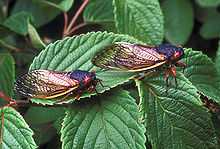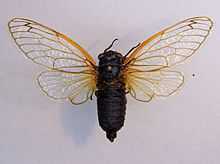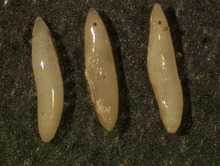Magicicada septendecim
| Magicicada septendecim | |
|---|---|
 | |
| | |
| Conservation status | |
| Scientific classification | |
| Kingdom: | Animalia |
| Phylum: | Arthropoda |
| Class: | Insecta |
| Order: | Hemiptera |
| Family: | Cicadidae |
| Genus: | Magicicada |
| Species: | M. septendecim |
| Binomial name | |
| Magicicada septendecim (Linnaeus, 1758) | |

Magicicada septendecim, sometimes called the Pharaoh cicada or the 17 year locust, is native to Canada and the United States and is the largest and most northern species of periodical cicada with a 17-year life cycle.[2]

Accounts of the species' life cycle cite reports of fifteen- to seventeen-year recurrences of enormous numbers of noisy emergent cicadas that people had written as early as 1737.[3][4] Pehr Kalm, a Swedish naturalist visiting Pennsylvania and New Jersey in 1749 on behalf of his nation's government, observed in late May one such emergence.[3][5] When reporting the event in a paper that a Swedish academic journal published in 1756, Kalm wrote:
The general opinion is that these insects appear in these fantastic numbers in every seventeenth year. Meanwhile, except for an occasional one which may appear in the summer, they remain underground.
There is considerable evidence that these insects appear every seventeenth year in Pennsylvania.[5]
Kalm then described documents (including one that he had obtained from Benjamin Franklin) that had recorded in Pennsylvania the emergence from the ground of large numbers of cicadas during May 1715 and May 1732. He noted that the people who had prepared these documents had made no such reports in other years.[5] Kalm further noted that others had informed him that they had seen cicadas only occasionally before the insects appeared in large swarms during 1749.[5] He additionally stated that he had not heard any cicadas in Pennsylvania and New Jersey in 1750 in the same months and areas in which he had heard many in 1749.[5] The 1715 and 1732 reports, when coupled with his own 1749 and 1750 observations, supported the previous "general opinion" that he had cited.
Based on Kalm's account and a specimen that Kalm had provided, Carl Linnaeus gave to the insect the Latin name of Cicada septendecim in the tenth edition of his Systema Naturae, which was published in Stockholm in 1758.[2][6]
Like other species included in Magicicada, the insect's eyes and wing veins are reddish and its dorsal thorax is black. It is distinguished by broad orange stripes on its abdomen and a unique high-pitched song said to resemble someone calling "weeeee-whoa" or "Pharaoh,"[7] features it shares with the newly discovered 13-year species Magicicada neotredecim.[8]
Because of similarities between M. septendecim and the two closely related 13-year species M. neotredecim and M. tredecim, the three species are often described together as "decim periodical cicadas."
References
- ↑ World Conservation Monitoring Centre (1996). "Magicicada septendecim". IUCN Red List of Threatened Species. Version 2.3. International Union for Conservation of Nature. Retrieved August 10, 2007.
- ↑ 2.0 2.1 Alexander, Richard D.; Moore, Thomas E. (1962). "The Evolutionary Relationships of 17-Year and 13-Year Cicadas, and Three New Species (Homoptera, Cicadidae, Magicicada)". University of Michigan Museum of Zoology. Retrieved 9 June 2011.
- ↑ 3.0 3.1 Marlett, C.L. (1898). "The Periodical Cicada in Literature". The Periodical Cicada: An Account of Cicada Septendecim, Its Natural Enemies and the Means of Preventing its Injury, Together With A Summary of the Distribution of the Different Broods (Bulletin No. 14 - New Series, U.S. Department of Agriculture, Division of Entomology). Washington, D.C.: United States Government Printing Office. pp. 112–118.
- ↑ Kritsky, Gene (2004). "John Bartram and the Periodical Cicadas: A Case Study". In Hoffmann, Nancy E. and Van Horne, John C. America's Curious Botanist: A Tercentennial Reappraisal of John Bartram 1699-1777. Philadelphia, Pennsylvania: The American Philosophical Society. pp. 43–51.
- ↑ 5.0 5.1 5.2 5.3 5.4 Davis, J.J. (May 1953). "Pehr Kalm's Description of the Periodical Cicada, Magicicada septendecim L., from Kongl. Svenska Vetenskap Academiens Handlinger, 17:101-116, 1756, translated by Larson, Esther Louise (Mrs. K.E. Doak)". The Ohio Journal of Science 53: 139–140. Archived from the original on 2012-10-02. Republished by Knowledge Bank: The Ohio State University Libraries and Office of the Chief Information Officer. Retrieved 2012-10-02.
- ↑ Linnaei, Caroli (1758). "Insecta. Hemiptera. Cicada. Mannifera. septendecim.". Systema Naturae Per Regna Tria Naturae, Secundum Classes, Ordines, Genera, Species, Cum Characteribus, Differentiis, Synonymis, Locis 1 (10 ed.). Stockholm, Sweden: Laurentii Salvii. pp. 436–437.
- ↑ Stranahan, Nancy. "Nature Notes from the Eastern Forest". Arc of Appalachia. Retrieved 10 June 2011.
- ↑ "Periodical Cicada Page". University of Michigan. Retrieved 10 June 2011.
External links
 Media related to Magicicada septemdecim at Wikimedia Commons
Media related to Magicicada septemdecim at Wikimedia Commons
